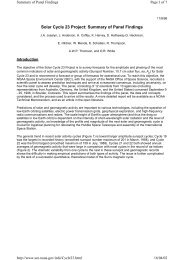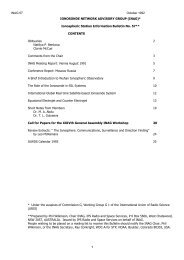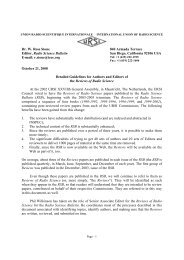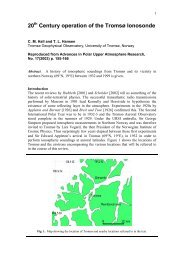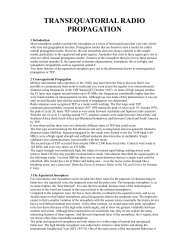UAG-93: Chapters 1 to 5 - URSI
UAG-93: Chapters 1 to 5 - URSI
UAG-93: Chapters 1 to 5 - URSI
Create successful ePaper yourself
Turn your PDF publications into a flip-book with our unique Google optimized e-Paper software.
AMODE is an input parameter specifying one of ten standard types of analysis, corresponding <strong>to</strong><br />
different values of NT, NV, NR and NH (Section 5.2).<br />
The nunber of frequencies used:<br />
NV is the number of 0-ray virtual-height data points (above FA) <strong>to</strong> which the polynomial is <strong>to</strong> be<br />
fi tted.<br />
NF is the number of 0-ray points actually used; normally equal<strong>to</strong> NV or <strong>to</strong> the number of 0-ray<br />
points available before a layer peak.<br />
NX is the nurnber of X-ray data points used (in start and va11eycalculations).<br />
This is commonly<br />
equal <strong>to</strong> the number available in the range FA <strong>to</strong> FM + 0. 1 MHz; points corresponding<br />
<strong>to</strong> FN > FM + 0.1 MHz are deleted.<br />
MV - NX + NF is the <strong>to</strong>tal number of virtual heights fitted.<br />
FM = FV(MF) is the highest 0-ray frequency used in the current step.<br />
l4F = KR + MV is the index corresponding <strong>to</strong> FM in the data arrays FV, HT'<br />
l4X = KR + NX is the index of the highest X ray used.<br />
The number of terms used:<br />
NT is the initial number of terms <strong>to</strong> be used in the polynomial real height expression.<br />
l'1T is the number of polynomial terms actually used wr'th.in P0LAN. This is normally equal <strong>to</strong><br />
NT + (NX+1)/2, with a maximum value of MV + NR.<br />
JM is the <strong>to</strong>tal number of real-height terms calculated, normally equal <strong>to</strong> MT. An additional<br />
term q(JM) lwjth JM = MT+l] is included at a valley, or with an X-ray start calculation,<br />
<strong>to</strong> provide a calculated shift or offset h - HA = q(JM) in the height of the origin FA.<br />
NR is the number of known real heights above FA <strong>to</strong> be included in the polynomia'l fit (Section 5.2).<br />
if NR is negative, fitting is <strong>to</strong> 1 real hejght below FA and <strong>to</strong> lNRl-1 heights above FA.<br />
NH is the number of new real heights <strong>to</strong> be calculated. This is equal <strong>to</strong> the number of points the<br />
origin is advanced for the next step. NH = 1 for Modes 1 <strong>to</strong> 6, except just before a peak<br />
when NH = NF so that real heights are calculated at all fitted (0-ray) frequencies.<br />
4- Start, Peak and Val'ley Calculations.<br />
fs, hs<br />
is the starting point for the profile calculatjon, with f5 (= fmin and hr




